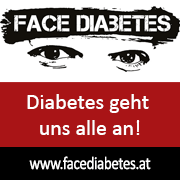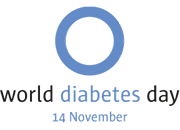Austrian Diabetes Report 2013
Short Version English
Definition – classification – diagnosis
- Diabetes mellitus denotes a group of metabolic diseases whose common finding is a chronically increased blood glucose level
- Diabetes mellitus is classified in four types (type 1 diabetes, type 2 diabetes, other specific forms of diabetes, gestation diabetes), type 2 diabetes by far being the most wide-spread diabetes disease.
- Diabetes is diagnosed using blood glucose measurements (fasting or after a meal), glucose tolerance tests, or measurement of haemoglobin A1c.
Causes and risk factors
- Type 1 diabetes is characterised by an absolute insulin deficiency. It is caused by an autoimmune reaction, severe diseases of or the loss of the pancreas.
- Type 2 diabetes, however, is caused by a combination of insulin resistance (decreased insulin impact) and insulin secretion disorder (relative insulin deficiency). The main causes of type 2 diabetes are overweight and adiposity, high blood pressure and increased lipid levels (metabolic syndrome) and thus a high-calorie, high-carbohydrate or high-fat diet and physical inactivity. These are causes that are significantly influenced socio-economically.
- During pregnancy, women can, induced by hormonal chance, develop a physiological insulin resistance, which can lead to gestation diabetes. Even though after childbirth c 90% of the women reach a normal glucose tolerance again, those women are seven times more likely to suffer from type 2 diabetes later in their lives.
Frequency
- On a global scale, c 3600 million people suffer from diabetes mellitus (c 8%, in their majority type 2 diabetes); 52 million of them in Europe (c 8%).
- As for Austria, the group of diabetics is presently estimated to comprise c 573,000 to 645,000 people (c 8-9%). This figure includes approximately 430,000 medically diagnoses cases of diabetes (c 6%), as well as an estimated 143,000 to 215,000 undiagnosed diabetics (c 2-3 %).
- In the group of 0-14-year-olds in Austria, a percentage of 0.1 can be assumed (c 1,000 to 1,500 children).
Consequences
- Diabetes mellitus often leads to health complications and secondary diseases. Usually, these are determined by changes to small and large vessels, which result in various illnesses affecting the eyes (retinopathy), kidneys (nephropathy), and nerves (neuropathy), and, in extreme cases in blindness, dialysis dependency, and amputation of limbs.
- In comparison with non-diabetics, diabetics have a much lower quality of living. The greatest differences are to be found in physical quality of living, followed by the psychological and social assessment of one’s situation. When directly compared, the differences between non-diabetic and diabetic women are almost always significantly greater than those between male reference groups.
- In 2011, c 2,900 deceased were documented to have died from diabetes mellitus in Austria; more often those were men than women. Approximately three quarters of those who died from diabetes were over 74 years old. The diabetes mortality follows a regional pattern, according to which age standardised mortality is the highest in eastern provinces and in the border districts of Lower Austria and Burgenland, while it is the lowest in western provinces.
- Approximately 8.4 per cent of health expenses paid for by health insurances can be ascribed to diabetics (c 1,700 million Euros; 50% for in-patient treatment and 30% for medication or medical consumables and non-consumables). The expenses for each diabetic patient are on average 2.6 (DMP patients) to 3.3 (non-DMP patients) higher than those for other beneficiaries. Furthermore, the per capita expenditure for DMP patients is c 700 Euros lower than that for non-DMP patients.
Treatment
- Diabetes mellitus counts among the most frequent causes why over-65-year-old patients consult a GP. As for chronic diseases, it comes in position #2 in terms of patient contacts. The distinctiveness in terms of health care as offered by a GP lies in a generalist approach and is normally well-suited for type 2 diabetics. The treatment of patients with type 2 diabetes either takes place within the framework of existing disease management programmes (DMPs) or according to the usage of each doctor’s office. How and to what extent these services are offered may vary in accordance with regional peculiarities as national regulations, medical fees, availability of other services, and individual circumstances, such as the size of a doctor’s office, training of staff, and professional self-conception.
- Presently, 95 diabetes walk-in clinics are provided for Austria’s adult population. On federal average, each of these clinics deals with c 4,500 diabetics who are potentially in need of treatment. 36 clinics are currently provided especially for children and adolescents. They deal, on a federal average, with 44 children and adolescents in need of treatment each. For both children and adolescents on one hand and adults on the other hand can be said that the percentage of diabetics potentially in need of treatment varies significantly from province to province. Availability analyses have shown that about 95 per cent of the 19-year-old diabetics and about 79 per cent of under-15-year-old children and adolescents with diabetes can reach one of these clinics within less than 30 minutes of driving.
- In Austria, advanced education to become a diabetes adviser open to medical doctors, nurses (DGKS and DGKS), as well as to dietologists, has been offered since the early 1990’s. Ever since about 850 persons have been trained accordingly.
- In six out of nine provinces, the disease management programme (DMP) “Therapie Aktiv” is currently offered. By improving diabetes treatment, the DMP aims to minimise the risk of diabetes-related complications and premature mortality. In addition, the DMP aims to improve the quality of living of participating diabetics.
- The Forum Quality Management in Diabetology Austria (FQSD-Ö) is an initiative founded in 1996 to improve the quality of structures, processes and results in diabetes treatment. Presently, 284 institutions are members of the FQSD-Ö; they all meet the quality challenge within the scope of an open benchmarking.
- The Tyrolean Diabetes Registry (DRT), based on data from all diabetes out-patient clinics in the province, is another quality improvement project aimed at optimising the medical care offered to diabetics. Additionally, the register generates epidemiological data that provide information on incidence and prevalence of diabetes and on diabetes-related risk factors and long-term complications.
- In 2011, 20,000 or so people received in-patient treatment in Austrian hospitals in connection with diabetes. Of these, 630 (3.3%) were children (14 years or under). As for children, statistics until 2007 showed an increase in in-patient treatment, whereas since 2007 the frequency of hospitalisation is stable at a figure of 50 per 100,000 children. As for over-14-year-olds with diabetes mellitus as their main diagnosis, a continuous decline in hospitalisation can be observed for the years since 2004.
- The experts of the project advisory board see a potential for improvement in diabetes treatment mainly in the following fields of activity: advice and treatment offered by residents in training, the linking of treatment facilities for in-patient and out-patient care, further extension of the DMP “Therapie Aktiv”, providing adequate treatment for children and adolescents with diabetes, further extension of the range of diabetes training courses for migrants, adding a physical activity module to the standardised diabetes education and training, easy access to certain drugs and medical products, acceptance of preventive check-ups, and with regard to personnel providung adequate resources for all treatment facilities.
Early detection and prevention
- Early detection measures are necessary to allow for the specific treatment of diabetic co-morbidities and complications at an early stage. Because of that, testing adults of any age group is worth considering if they are overweight or obese and have one or several of the following risk factors: gestational diabetes, physical inactivity, high blood pressure, increased lipid levels, cardiovascular diseases, first-grade relatives who have diabetes and age 45 or older.
- The risk of developing diabetes can be reduced through specific lifestyle modification, via education and information and via preventive measures that help to avoid certain behavioural patterns (workplace health promotion, healthy canteen food, exercise, etc). These measures aim above all at physical activity and nutrition behaviour among the population. These are basis for a propitious direction in order to avoid overweight, obesity, high blood pressure and increased lipid levels.
Gender aspects
- Gender influences health-related behaviour as well as development and progression of diabetes. Not only biological diversity but also psychosocial factors come into play (e.g. character, social status, etc). Women with a low social status have a higher diabetes risk, while men for instance have a lesser insulin susceptibility. Furthermore, diabetic women estimate their own quality of living to be far worse than male diabetics do; this affects the physical but even more the psychological quality of living.
Österreichischer Diabetesbericht 2013 - GERMAN VERSION (PDF - 3MB)









